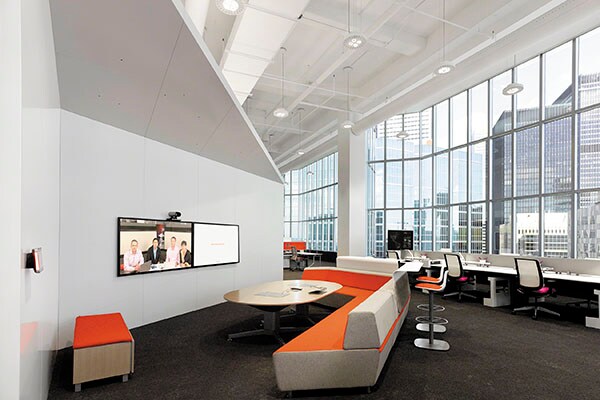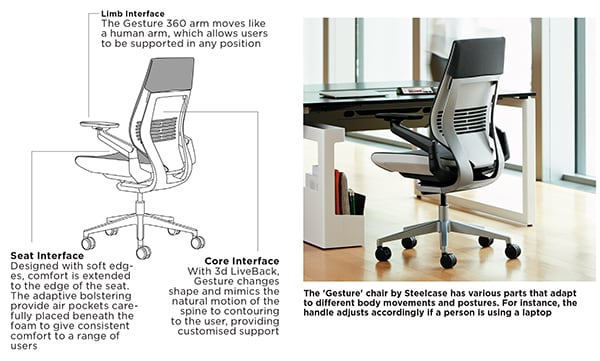Making design work: Ergonomics shapes today's workspaces
Ergonomics not only improves our posture, but also our way of working and interacting, says Uli Gwinner of Steelcase, a global leader in office space design and manufacture


Steelcase Inc, which started its journey as a maker of office furniture in 1912, has evolved into a global leader in the designing and manufacturing of ergonomically designed office spaces, furniture, technology products and services. In an interview to Forbes India, Uli Gwinner, 52, president of Steelcase, Asia-Pacific, talks about the importance of ergonomics in the life of office employees, and the role that it plays in shaping an organisation’s culture and future. Edited excerpts:
Q. How has ergonomics become important for office and furniture design?
If you look at the development of ergonomics in the last one-and-a-half decades, we are seeing a significant shift. Ergonomics, 10 years ago, was more about design for static postures—sitting in an office, at a workspace or at a desk. The whole idea was to develop a product that would make you feel comfortable while you were sitting.
But the attitude towards a sedentary lifestyle has changed dramatically. We now know that people should not be sitting in office the whole day, and not moving. People really should move as much as possible, even if they have a white-collared job.
If people are sitting, we want them to move while they are sitting hence we are designing all our sitting products in a way that allows and encourages motion while they are sitting. There is nothing like an ergonomically correct posture the best posture is always your next posture. All furniture that allows motion and allows you to move your body as much as possible is good. This is the idea of dynamic seating.
If you change your posture as often as possible during the day, it is a good thing, and even if you walk as many steps as possible, it is good. So we try to design offices in a holistic way today, which allows people to change places often frequently during the day.
There was a time when you came to your office, dropped your coat in the cloakroom, went to your desk, sat there for eight hours, and then went home. Those days are over. We are providing these choices so that employees can choose the posture they work in, and they can change their postures as often as they want.  Steelcase holistically designs office spaces by understanding the behaviour and needs of people
Steelcase holistically designs office spaces by understanding the behaviour and needs of people
Q. When did Steelcase start holistically designing office spaces?
We have been doing this for a long time. We believe that we are working at the intersection of the social behaviour of people, technology, and the impact of space on people’s behaviour. Steelcase acquired a company called IVO almost 20 years ago. IVO is famous for its design process, which includes observing and understanding the behaviour and needs of people. We call this insight-led design or human-centred design, and this has influenced our thinking for more than two decades.
We have been bringing technology products that manage your space [with services] like room reservation systems, or digital content sharing systems. These products are called RoomWizard or Media:Scape. These products also try to support positive behaviour among people in the workspace.
Q. Are these software technologies that you are integrating into the designing of an office?
Exactly. These are digital devices that carry our software and they allow you, for example, if you work in a corporation with a global footprint, and you sit in Shanghai, and want to organise a meeting in the Mumbai office tomorrow, to book a room you have a visual signal in this room that shows it is reserved for you.

The 'Gesture' chair by Steelcase has various parts that adapt to different body movements and postures. For instance, the handle adjusts accordingly if a person is using a laptop
As office work gets more mobile, and people move around more, it is important that they have the opportunity to reserve space, because we found out that privacy is important for working alone or in small groups, in an undisturbed and focussed manner people are not satisfied with their workplace if they cannot focus and concentrate.
This explains how we have migrated from being an office furniture manufacturer to becoming a work experience company.
Q. Are there certain categories of office spaces, or furniture, which need to be more ergonomically designed than others?
Ergonomics plays a role in any piece of furniture, but some need more attention and effort to get it really right. If you go to Silicon Valley, for example, where you have programmers sitting for 15 hours in their chairs and just writing code, they really need a great product that is working and moving very smoothly. This probably requires more engineering and mechanical effort to get it right, compared to a table in a meeting room where people are spending only 10 minutes. For short meetings, you’d rather have a table where people are meeting in standing postures, because if you provide standing-height tables and no chairs, automatically meetings are shorter. Space shapes behaviour.
Q. What are the factors that you should accommodate when you come up with a design?
You have to consider how people will be living and moving in a space. This is how we structure office spaces, whether we provide sitting-posture workstations or standing-posture workstations, height-adjustable desks, a work-café where people can come together in an informal way, or a boardroom with a lot of technological equipment. It depends on how a company wants to work in that space. This is why we try to find out what the cultural journey of the company should be, and how we can support it with our space design.
It’s important to understand how the company is working and how we can support it in the best way to achieve its long-term targets. If you design a space, normally it’s something you do for the next decade, so you have to look ahead.  Q. How do you determine the needs of your client?
Q. How do you determine the needs of your client?
We do things like photo observation. We go to the sites of our customers and observe how people work there. We conduct moderated workshops, have online questionnaires to better understand how they work, and how they want to work in the future. We also bring in ideas from other projects that we have done around the world and global workplace trends.
Q. How do clients see the need for ergonomically designed workspaces? How has their view evolved over the last 10 to 15 years?
Our customers are far beyond talking about ergonomics. It’s something that they simply expect from us. What they are expecting now is that we create spaces that increase the level of engagement within their people. We did a global workspace survey, which included [representatives from ] 17 countries, and found that more than 85 percent of the global workforce is not really engaged. We know now that there is a correlation between engagement and work satisfaction, which means people who are highly engaged are also satisfied with their workplace. This satisfaction is coming from the freedom that they have to move around.
First Published: Sep 13, 2016, 06:16
Subscribe Now